Searching for information on quartz stones? Look no further. This versatile mineral, beloved for its aesthetic appeal and strength, straddles the line between beauty and utility. With applications ranging from spiritual healing to chic home decor, quartz stones promise an intriguing exploration of their impact on daily life and wellness. This article guides you through the rich landscape of quartz, from its natural formation to its multifaceted roles.
Key Takeaways
-
This is a diverse mineral family, including Quartz varieties like clear quartz, amethyst, citrine, rose quartz, and smoky quartz. Quartz is known for its beauty, healing properties, and hardness of 7 on the Mohs scale.
-
Clear quartz is regarded as the ‘master healer.’ When worn as jewelry or placed in living spaces, it is believed to enhance positive energy, promote mental and physical balance, and align with personal intentions.
-
Quartz crystal formations result from geological processes involving cooling silicate magma or high-temperature gases. Their healing capabilities are tied to stimulating the immune system and enhancing mental clarity and focus.
Understanding Quartz and Its Many Forms
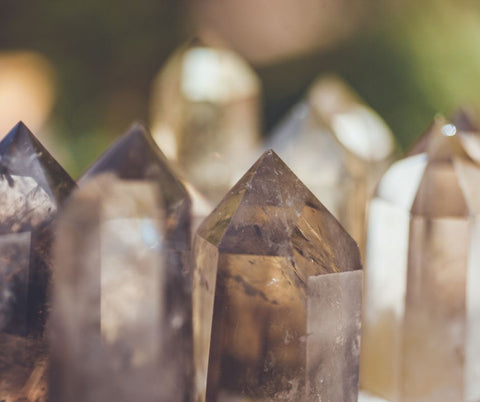
Quartz encompasses a diverse family of stones that paint the mineral kingdom with every colour of the rainbow. Some members of this extensive clan include:
-
Clear quartz
-
Amethyst
-
Citrine
-
Rose quartz
-
Smoky quartz
This natural wonder, known for its hexagonal and trigonal crystal system and impressive hardness of 7 on the Mohs scale, stands as a testament to both the beauty and resilience of Mother Nature’s creations.
Quartz, with its unique ability to declutter the mind, body, and spirit, helps us align with our full potential and serves as a cornerstone in the quest for balance and wellness.
Clear Quartz Crystal: The Master Healer
Clear quartz, the master healer among crystals, is revered for its capacity to provide meaning in various aspects of life. The clear quartz crystal meaning encompasses its role as a powerful tool to align with one's highest self, increase clarity on desires and manifestation, and drown out both external and internal distractions.
It is celebrated for its ability to amplify energy, protect against negative influences, enhance well-being, intuition, and focus, and raise vibrational levels. This makes clear quartz an invaluable ally in encouraging clarity to help carve a path to achieving life’s objectives, magnifying natural healing abilities, and amplifying energy and intentions.
Emotionally, clear quartz:
-
Promotes balance
-
Stimulates brighter feelings
-
Extends a protective shield against negative energies
-
Crafts an aura of tranquillity and protection
The clear quartz crystal properties highlight its significance in enhancing clarity of mind, especially during tough decisions, and in aligning with one's highest self, creating clarity of mind, and manifesting intentions.
The versatility of clear crystal quartz is unmatched, allowing it to be worn as jewelry or carried in a pocket for continuous alignment with personal intent and tapping into its healing vibrations, thereby leveraging these properties for emotional and spiritual well-being.
The Geological Journey of Quartz Stones
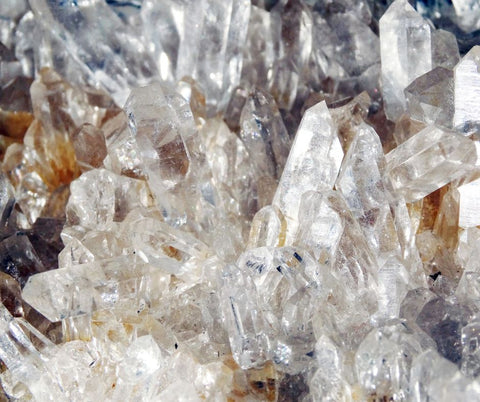
Quartz’s story begins deep within the Earth, where silicate magma or high-temperature gases and solutions set the stage for its formation. In this fiery crucible, quartz takes shape, crystallizing in volcanic and sedimentary rocks as a byproduct of geofluid precipitation. The environmental conditions dictate the size and perfection of quartz crystals; a leisurely cooling process akin to the gradual freezing of water into ice allows for the growth of large, well-formed crystals.
This intriguing geological process is akin to a dance of elements, where temperature and pressure orchestrate the formation of the crystalline structure.
From Magma to Mineral Kingdom
The journey of quartz crystals in igneous rocks is a tale of patience and precision. As the magma cools slowly beneath the Earth’s surface, it provides the perfect nursery for the growth of large quartz crystals. Geothermal waters also play a pivotal role in quartz formation, as silica-rich solutions crystallize when encountering a drop in temperature or pressure.
From the fiery depths of volcanic conditions emerge the crystalline forms of tridymite, cristobalite, and rock crystal, marking the diverse expressions of quartz in nature.
Silicon Dioxide: The Building Block of Quartz
At the heart of every quartz stone lies its fundamental compound, silicon dioxide (SiO2), the chemical backbone that defines its very essence. Quartz manifests in various physical forms, ranging from majestic single crystals to stones composed of dense microcrystals, each form a unique fingerprint of the conditions under which it formed.
Quartz crystals, one of the most abundant minerals, emerge from silica-rich environments, similar to sugar crystals forming from a saturated solution, thus earning their place as Earth’s crystalline treasures.
Harnessing the Healing Qualities of Quartz Stones

Quartz stones captivate not only with their physical beauty but also with their profound healing abilities. The 'clear quartz meaning' encompasses its role as a 'Master Healer,' celebrated for its spiritual growth, healing properties, and unparalleled ability to amplify positive energy.
This crystal connects deeply with chakras and higher planes, attracting more of what one desires through its clear, luminous presence. Clear quartz crystal stone, in particular, acts as a beacon of positivity, stimulating bright feelings and boosting the immune system while serving as a guardian against negative energies.
Blue quartz adds a unique touch of colour to this family of stones, enhancing the spectrum of healing and energetic support they offer.
The stone’s capability includes:
-
Enhancing stamina and endurance
-
Powerful revitalizing energies
-
Dispersing light and energy in a room
-
Creating an environment brimming with strength and vitality.
Physical Healing and the Immune System
Clear quartz’s reputation as a healing stone is not unfounded; it is known to stimulate the immune and circulatory systems, potentially enhancing physical well-being. It has also been used topically to soothe painful areas, and elixirs made from clear quartz are said to be beneficial for treating skin disorders.
The habit of wearing a clear quartz bracelet, especially on the left hand, focuses and absorbs the stone’s healing qualities, promoting a balanced and healthy resonance within the body.
Mental Clarity and Dispelling Static Electricity
Clear Quartz is not only a healer of the body but also a purifier of the mind. It is renowned for its ability to enhance focus and mental clarity, supporting cognitive functions that are essential in our daily lives.
The presence of this stone in a workspace, such as a home office, can enhance productivity. It aids in maintaining focus and precision, enabling one to tackle tasks with a clear and composed mind.
Chakras Clear Quartz Connection
The sublime clear quartz crystal is intrinsically linked to the concept of chakra balancing. Its energy is known to align and harmonize all the chakras, ensuring a fluid and peaceful energy flow throughout the body. The unique properties of crystal quartz make it an essential component in this process.
Its special resonance with the Crown Chakra opens the gates to spiritual connection and enlightenment, a testament to its profound influence on the human energy system.
The Magical Powers of Quartz Through History

Throughout history, quartz has bewitched humanity with its magical powers and mystical properties, captivating the imaginations across various cultures. The ancient Greeks, for instance, saw quartz as a form of permanent ice, a belief that underscores the stone’s longstanding veneration.
Its role as a potent talisman in Ancient Roman, Egyptian, and Greek cultures further attests to its widespread mystical reputation. At the same time, its inclusion in healing potions during the Middle Ages reflects its purported medical benefits.
The crystal ball, a quintessential symbol of divination and crystal gazing, further illustrates quartz's historical significance. Used in ancient practices for finding lost articles, foretelling secrets of the future, and detecting minor offenses and crimes, crystal balls are deeply rooted in the lore of magical and mystical powers. Their use as tools for scrying and symbols in various cultures and religions highlights the enduring fascination with quartz's ability to connect the physical and metaphysical realms.
Quartz in Ancient Lore
Quartz’s mystical allure stretches back to ancient times when civilizations like Atlantis and Lemuria revered its rejuvenating power, deeming it integral to their energy advancements. The Egyptians, in particular, believed in the talismanic power of quartz crystals, associating them with longevity and vitality.
Its historical application in healing practices further underscores the stone’s versatility, offering cures for a variety of conditions and serving as a protective amulet against harm.
The White Dragon of the Mineral World
In the vast expanse of the mineral kingdom, quartz reigns as the ‘white dragon’ — a symbol of universal purity and strength that parallels the revered mythical creature. Just as the dragon in Chinese culture represents power, strength, and good luck, quartz embodies these attributes in its role within the world of minerals.
In the practice of Western alchemy, quartz was equated with the purity and perfection of the Philosophers’ Stone, reinforcing its image as a transformative and enlightening ‘white dragon.’
Practical Applications of Quartz in Daily Life
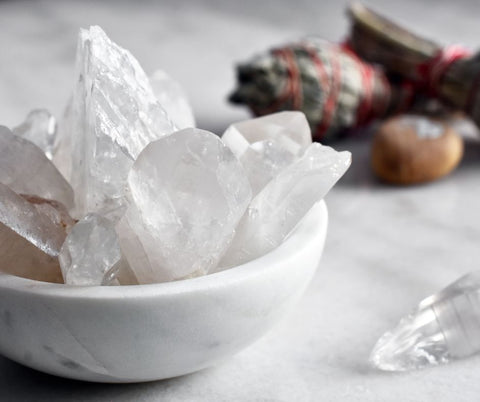
Quartz, besides being a wonder to behold, also serves as a practical companion in our daily lives. Its placement in personal spaces such as homes and workplaces harnesses its positive energy, contributing to the well-being of those within these environments.
The benefits of wearing clear quartz jewelry are manifold. The stone ensures maximum energy absorption and provides a constant source of healing light and energy.
Quartz in Home Decor and Feng Shui
The versatility of clear quartz allows it to be seamlessly integrated into home decor and feng shui practices. Its ability to absorb light and transform it into energy creates a sense of harmony and balance within a space, while its neutral appearance complements various decor schemes.
Positioning clear quartz in strategic locations, such as the center of the home or near the entrance, invites the qualities of the metal element and energizes the Tai Qi, enhancing the overall well-being of the home’s inhabitants.
Jewelry and Personal Adornment
The allure of quartz has seen it fashioned into various forms of jewelry throughout history, symbolizing purity and emotional balance. Wearing clear quartz jewelry, such as bracelets on the left hand for absorption or the right hand for releasing energies, enables the wearer to work in harmony with the stone’s vibrations, tapping into its transformative properties.
Meditation and Manifestation Tools
The spiritual applications of clear quartz are as profound as its physical beauty. During meditation, clear quartz can be utilized to amplify intentions and enhance mental clarity, aiding in achieving a deep meditative state.
The creation of crystal grids using quartz stones in geometric patterns can further deepen meditation and enhance intuitive connections. It is a powerful method for realizing one’s goals and dreams. In a way, these grids act like crystal balls, providing insight and guidance on the path to success.
Caring for Your Quartz Collection
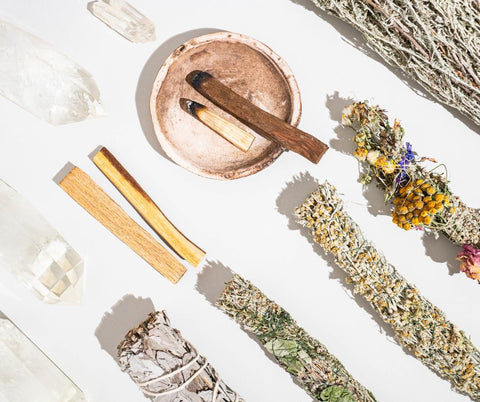
A collection of quartz is a cherished possession that necessitates careful preservation to maintain its pristine condition. Storing and cleansing your clear quartz jewelry and accessories properly ensures they remain safe from damage and retain their powerful energies.
Cleaning and Charging Quartz Crystals
Regular maintenance of quartz crystals is essential for their longevity and efficacy. Here are some methods you can use to cleanse your quartz crystals:
-
Manual cleansing under tepid water can refresh the stone.
-
Water rinsing can help remove stubborn mineral coatings.
-
Using oxalic acid can be effective in cleaning quartz crystals.
-
Household bleach can also be used to remove mineral coatings.
-
In some cases, muriatic acid may be necessary to clean quartz crystals.
By following these methods, you can ensure that your quartz crystals remain in good condition.
Charging techniques, such as basking in moonlight or smudging, infuse the quartz with purifying energy, readying it for continued use.
Storing and Displaying Quartz Safely
Quartz crystals should be stored in clean, dry, and dark areas when not in use to prevent environmental damage.
Displaying quartz on pedestals not only keeps them free from dirt but also enhances their appearance, allowing their natural beauty to shine through.
Crafting Your Own Quartz Crystal Arrangements
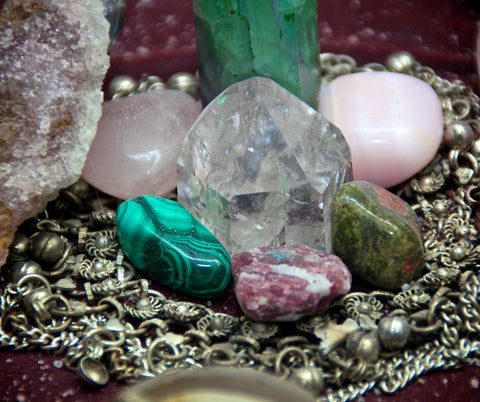
Customizing your space with arrangements of quartz crystals can intensify intentions and foster an environment conducive to focused energy work. When combined with other stones, quartz’s properties can be enhanced, creating unique energy blends that cater to specific needs.
Designing a Quartz Altar
Creating a quartz altar is a sacred process that begins by selecting a significant space in the home. It is ideally initiated on a new moon to symbolize new beginnings. The arrangement of crystals and symbolic objects on the altar should be guided by intuition. Each object should have a purpose that reflects the altar’s overarching intention.
Combining Quartz with Other Stones
The art of combining quartz with other crystals allows for the creation of tailored energy blends, enhancing the properties of the stones involved. Some examples of crystal combinations include:
-
Clear quartz with amethyst to elevate energies of self-love and intuition
-
Clear quartz with rose quartz to enhance feelings of love and compassion
-
Clear quartz with citrine to amplify abundance and prosperity
-
Clear quartz with black tourmaline for grounding and protection
Whether it’s pairing clear quartz with amethyst or creating a synergistic effect with other stones, the possibilities are boundless.
Summary
As we conclude this journey through the sparkling corridors of quartz crystals, we are reminded of their timeless allure and the profound impact they can have on our lives. From understanding their many forms and geological origins to harnessing their healing qualities and appreciating their historical significance, quartz crystals offer a wealth of benefits that transcend the aesthetic. By integrating these stones into our daily lives, caring for them, and crafting personalized arrangements, we invite their transformative power into our personal space, allowing us to live in greater harmony with ourselves and the world around us.
Frequently Asked Questions
Is quartz a precious stone?
Quartz is not typically considered a precious stone but rather a semi-precious gemstone.
Can clear quartz crystals be used to cleanse other stones?
Yes, clear quartz crystals can be used to cleanse other stones because of their powerful purifying properties.
Who should wear quartz stone?
Anyone seeking clarity, balance, or amplification of energy may benefit from wearing quartz.
Are there specific quartz crystals associated with each chakra?
Yes, clear quartz is connected to all the chakras, while specific crystals like rose quartz and amethyst can be used for targeted chakra work. Consider using rose quartz for the heart chakra and amethyst for the crown chakra.
What energy does quartz crystal have?
Quartz crystal is believed to possess cleansing, healing, and balancing energies.
Can quartz crystals help with sleep?
Yes, placing clear quartz near your bed or under your pillow can help improve sleep quality by promoting a sense of calm and dispelling negative energy.
What energy does clear quartz absorb?
Clear quartz is believed to absorb, store, and amplify energy, making it versatile for various healing practices.









